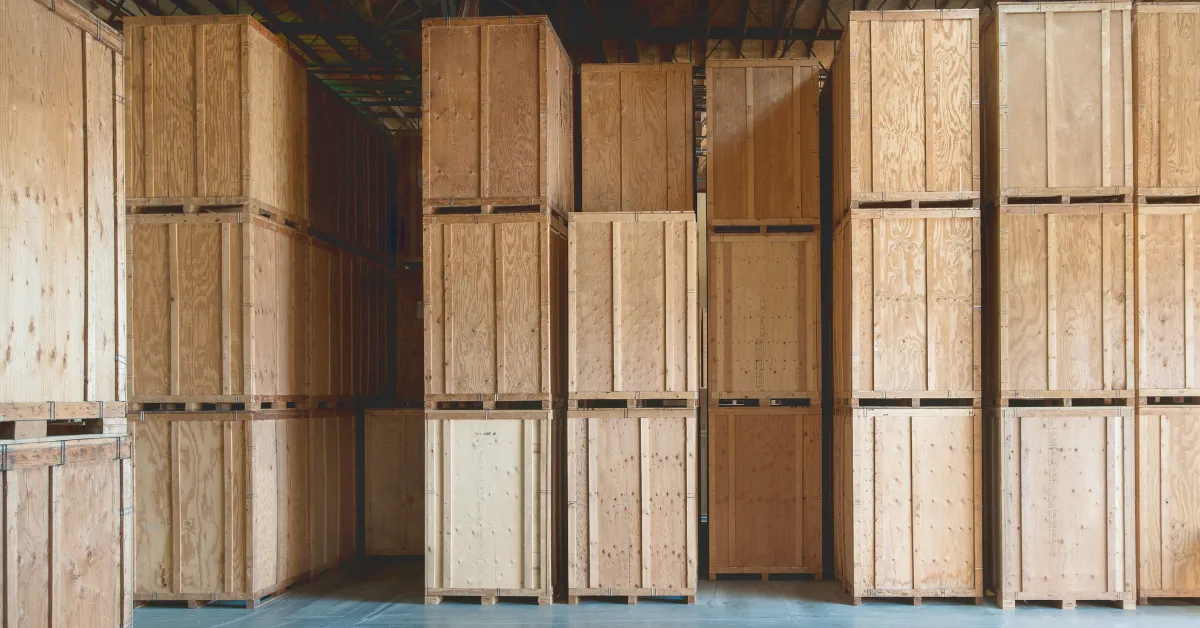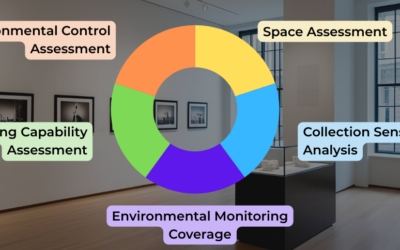Transporting art is a delicate and complex process that requires careful planning and execution. Artworks are often fragile, valuable, and irreplaceable, and they need to be protected from damage, theft, and environmental factors during transit. However, transporting art also has an environmental impact that can affect the sustainability of the art world and the planet. This is not merely a factor of the fuel costs of shipping art but is also directly related to the diverse packaging options we use – many of which have not been traditionally reusable or recyclable. How can collections care professionals balance the need for safety and security with the desire for environmental responsibility?
One of the key factors influencing the sustainability of art transport is the choice of crating. Crates are the containers that hold and protect artworks during transport, and they come in different shapes, sizes, materials, and designs depending on the item to be transported. Some crates are more eco-friendly than others, depending on how they are made, used, and disposed of. In this article, we will explore some of the most popular crating options for art transport today, and how they compare in terms of sustainability.
Arca (Germany)
Arca is a relatively new brand of reusable crates by the Hasenkamp group that are designed to minimize waste and carbon footprint. Arca crates are made of various materials. Wood is used as the main material. Arca claims that 8% of all its wood is sourced locally (Germany) and 83.8% from Europe, thus reducing the fuel spent in bringing the materials to the place of manufacture. The important aspect about the choice of wood as a sustainable material is that it is a climate-positive product. Growing trees actively takes carbon dioxide out of the atmosphere so using fast-growing trees (Paulownia tomentosa) that get harvested quickly, keep CO2 sequestered in crate form, and are replanted is an excellent way to reduce a carbon footprint. The other materials in the Arca crate, such as plastics and rubber are recycled and recyclable as much as possible. In total, the crate is about 55 kg only (121lbs), which makes it more fuel-efficient during transport.
Since the crates are modular and customizable, they can fit several different sizes of art – although it is mostly suited for flat items such as paintings. They can also be rented so that you are not purchasing them, and the company will reuse them several times before they need to be refurbished. Arca also claims to be both Oddy tested and IPPC certified.
ROKBOX (UK)
ROKBOX is a brand of reusable crates made of composite materials. They claim to be fully recyclable or repurposed at the end of their useful life. Regarding safety standards, they have been designed in collaboration with collections specialists as well as industrial designers, insurers and environmental scientists so that ROKBOX crates are resistant against vibration, shock, drops, topples, water showers and floods, temperature and humidity as well as forklift puncture accidents.
ROKBOX displays several interesting logos on their website including a Verified Carbon Standard, the AIC’s Sustainability Tools in Cultural Heritage and an active membership with the Gallery Climate Coalition.
Turtle (The Netherlands)
Turtle has been around since 1994 and was developed by Dutch art transport provider Hizkia. Turtle claims to be “the most sustainable climate crate available on the market today” and has a crate life expectancy of at least 20 years. They have an international network of availability in North America, Australia, New Zealand and Singapore, the Benelux Union (Belgium, Netherlands, Luxembourg), Denmark and Finland, Italy, Portugal and the United Kingdom.
Turtle crates are made of composite materials (wood, rubber, plastic, velcro) which make them lightweight, waterproof, and shock-resistant, making them ideal for transporting artworks in harsh conditions. They are stackable and nestable, saving space and fuel during transport. According to their website, they are also 99% recyclable at the end of their life. Turtle shows a Climate Neutral Certificate and claims to be well on its way to reducing CO2 emissions by 25% in 2030.
Turtle crates can be rented or purchased, and they can be reused for multiple shipments. If you are interested in seeing their various tests for vibration, shock, and insulation, go check out their website for the downloadable test results.
Quick summary
Did we miss any options? Let us know and we will update this!
Make your own with CCI?
Did you know the Canadian Conservation Institute has instructions to make yourself a lightweight, reusable crate? It’s called the CCI Channel Crate and they have very detailed instructions on how to construct your own with plywood, wood screws, and glue.
“The material and fabrication costs of a high-quality plywood crate plus the cushioning required for a medium-sized painting can approach $1,000. The cost of a channel crate and cushioning for the same painting is approximately $450, plus triwall cover material at a cost of $20 per sheet. This can reduce packaging costs by as much as 50%. For a scenario where the sender supplies the crate on a loan basis and the recipient covers the cost of the cover panels plus return shipment of the major crate parts back to the sender, the savings can approach 80% or more.”
While the exact sustainability metrics for this crate are not specified, if this type of crate is appropriate for your purposes, the carbon footprint of making it in house (if you already have the staff and most of the materials) may very well be lower than importing a crate. This is something you would have to calculate for yourself based on your particular conditions.
As collections care professionals, we have a responsibility to preserve not only the artworks we transport but also the environment we live in. Choosing sustainable crating options is one way to reduce the environmental impact of art transport, while still ensuring the safety and security of the artworks. The crating options we discussed in this post are the main ones today, but there may be other alternatives or innovations in the future. Make sure you evaluate each option based on its advantages and disadvantages and choose the one that best suits your needs and values. If you’d like to hear the experience and recommendations of your colleagues using these crates, start a thread in the Conserv Community!
Sustainability at Conserv
If sustainability is important to you, there are a few things you should know we do at Conserv.
- We use a circular design model. Our devices are designed so that everything that goes into them can either be reused, refurbished, or recycled (in that order). The radio board can be reused for a very long time. The sensor board is recycled. The external enclosure can be reused or recycled as it is made of HDPE.
- As a Conserv subscriber, we replace your sensors every three years. This means you will never have to discard them.
- We will refurbish your old sensors and use them again with new internal components, so waste is minimized.
- We donate 0.5% of our revenue to carbon removal technology through Stripe Climate.
Disclaimer: The information provided in this article is meant to help you compare your options and has been retrieved from the official websites of the products mentioned in December 2023. Conserv does not endorse them and is not in commercial partnerships with any of them. Please make your own enquiries directly with the companies as Conserv is not responsible for changes in the products mentioned in this post.
If you have any questions about environmental monitoring, integrated pest management, or just want to talk about preventative conservation, please reach out to us! Don’t forget to check out our blog or join our community of collections care professionals where you can discuss hot topics, connect with your peers or even take a course to get familiar with the Conserv platform.




